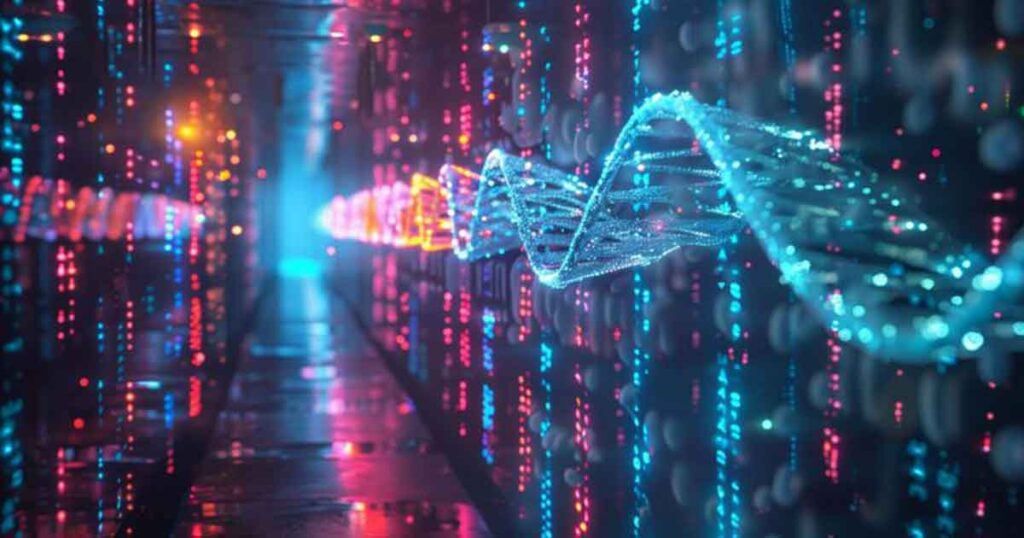Revolutionizing the Future: How DNA Data Storage Will Transform Computing Forever!
DNA Data Storage Computing
Breakthrough in DNA Tech: Unleashing Next-Gen Data Storage Capabilities
Researchers from North Carolina State University and Johns Hopkins University have pioneered a revolutionary technology that harnesses DNA for data storage and computing, enabling not only the storage, retrieval, and computation of data but also its rewriting.
This groundbreaking development is made possible by innovative polymer structures known as dendricolloids, which significantly enhance data density and preservation.
This technology mirrors the functions of traditional electronic devices and holds the potential to secure data for millennia, laying a promising groundwork for the future of molecular computing.
DNA Data Storage and Computing
Scientists at NC State and Johns Hopkins have showcased a DNA-based technology capable of performing a comprehensive array of data storage and computing tasks.
This includes the ability to store, retrieve, compute, erase, and rewrite data—a feat that was previously unattainable with earlier DNA-based technologies.
“In conventional computing, we often overlook the seamless compatibility between data storage and processing,” explains project leader Albert Keung, an associate professor of chemical and biomolecular engineering at NC State.
“However, in reality, these processes occur in separate parts of a computer, forming a complex network of technologies.”
Keung further elaborates on the challenges faced by DNA computing, particularly in achieving compatibility between storage and computation when dealing with nucleic acids.
“While electronic computing benefits from the compatibility of all its components, DNA data storage has been limited to long-term storage, with the full range of operations seen in traditional electronic devices—such as storing, moving, reading, erasing, and rewriting data—remaining a significant challenge.”
Breakthrough in DNA-Based Technology
“We’ve proven the viability of these DNA-based technologies by successfully creating one,” Keung states.
This technological advancement is attributed to recent breakthroughs in creating soft polymer materials with unique morphologies. Specifically, researchers have developed polymer structures, dubbed dendricolloids, which start at the microscale and branch out hierarchically to form a network of nanoscale fibers.
“This morphology results in a structure with an extensive surface area, allowing us to embed DNA among the nanofibrils without compromising the data density that makes DNA so attractive for storage,” explains Orlin Velev, co-corresponding author and the S. Frank and Doris Culberson Distinguished Professor of Chemical and Biomolecular Engineering at NC State. “You could condense data from a thousand laptops into DNA-based storage the size of a pencil eraser,” Keung adds.
Innovative Functions and Practical Applications
The ability to differentiate DNA information from the nanofibers on which it’s stored allows for functionalities comparable to those of electronic devices. “We can replicate DNA information directly from the material’s surface without damaging the DNA.
Additionally, we can selectively erase and rewrite DNA, akin to managing data on a hard drive,” says Kevin Lin, the study’s first author and a former Ph.D. student at NC State. This innovation permits the full range of DNA data storage and computing functions, while the dendricolloid material aids in DNA preservation.
“Keung’s team essentially provides the microcircuits, while my team’s dendricolloidal material acts as the circuit board,” Velev explains.
“Our collaborator at NC State, Adriana San Miguel, integrated the materials into microfluidic channels, directing the flow of nucleic acids and reagents, which facilitates data movement and the initiation of computing commands.
Meanwhile, Winston Timp’s lab at Johns Hopkins contributed nanopore sequencing expertise, enabling us to directly read RNA data after copying it from DNA on the material’s surface. Additionally, James Tuck’s lab at NC State developed algorithms to convert data into nucleic acid sequences and vice versa, while controlling for potential errors.”
Future Prospects and Implications
The researchers have demonstrated the potential of this new data storage and computing technology—referred to as a “primordial DNA store and compute engine”—by solving simple Sudoku and chess problems. Testing indicates that the technology could securely store data for thousands of years without degradation in commercially available spaces.
“What’s more, the dendricolloidal host material is relatively inexpensive and straightforward to fabricate,” Velev notes.
“There is significant enthusiasm for molecular data storage and computation, yet questions linger regarding the practicality of the field,” Keung observes.
“We reflected on the history of computing, particularly the inspiration derived from ENIAC’s creation, and aimed to develop something similarly inspiring for molecular computing. We hope our work marks a step in that direction.”
Reference
“A Primordial DNA Store and Compute Engine,” Nature, August 22, 2024
Co-authors include Kevin Volkel and Andrew Clark, former Ph.D. students at NC State; Cyrus Cao and Rachel Polak, current Ph.D. students at NC State; Adriana San Miguel, an associate professor of chemical and biomolecular engineering at NC State; James Tuck, a professor of electrical and computer engineering at NC State; Winston Timp, an associate professor of biomedical engineering at Johns Hopkins University; and Paul Hook, a postdoctoral researcher at Johns Hopkins.
This research was funded by the National Science Foundation under grants 2027655 and 1901324.
Keung and Tuck are co-founders of DNAli Data Technologies, with a vested interest in translating and commercializing DNA-based information systems. Keung, Volkel, Tuck, and Lin are inventors on patent application WO 2020/096679, which has been licensed to DNAli Data Technologies and underpins some of this work.







